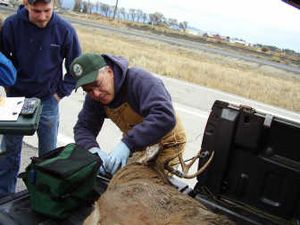Hunters’ help sought for wildlife disease monitoring
HUNTING -- As part of an ongoing effort to watch for Chronic Wasting Disease, the Washington Department of Fish and Wildlife is asking deer and elk hunters to submit tissue from animals harvested east of the Columbia River.
The fatal illness of deer and elk has not yet been detected in Washington, but it has occurred in at least 15 other states and the Canadian provinces of Alberta and Saskatchewan. WDFW has tested over 5,000 animals in the state over the past 15 years in its CWD-monitoring efforts.
Hunters can submit their harvest for CWD testing in any of the following ways:
- Stop at a WDFW hunter check station off Highway 395 near Deer Park or State Route 2 near Chattaroy on most weekends during deer seasons.
- Deposit the head of the harvested animal in a marked collection bin at the laboratory building behind the Spokane Valley WDFW office, 2315 N. Discovery Place
- Deposit the head of the harvested animal at the Inland Northwest Wildlife Council office, 6116 N. Market St. in Spokane during office hours (Mon.-Fri., 8 a.m. – 5 p.m.).
- Arrange to have the sample picked up anywhere in Spokane or Spokane Valley by calling (509) 989-6224, or in the Tri-Cities area by calling (509) 531-2691.
Although there is no scientific evidence at this time that CWD can be transmitted from deer or elk to humans, hunters should always follow basic hygienic precautions such as wearing rubber gloves while field-dressing game, and thoroughly washing hands and equipment after handling harvested animals, Mansfield advised.
Read on for more details on what type of tissue samples are required:
The tissue sample requires four inches of neck tissue attached to the head. To complete the test, lymph nodes are removed from the animal’s neck, said WDFW Veterinarian Kristin Mansfield.
Hunters who submit samples and complete contact-information cards will be entered into a drawing for a $200 Cabela’s sporting goods store gift certificate, donated by the Inland Northwest Wildlife Council, which is also providing the winner a one-year council membership.
As part of the effort to keep CWD out of Washington, state law prohibits importation of certain body parts from deer, elk or moose harvested from locations where CWD occurs. Details of those restrictions are listed on page 87 of Washington’s 2011 Big Game Hunting Seasons and Regulations pamphlet. The pamphlet can be viewed online at http://wdfw.wa.gov/hunting/regulations/.

